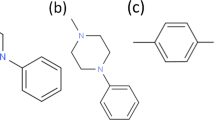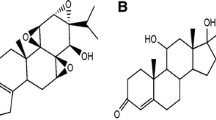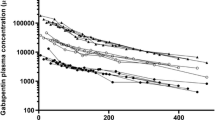Abstract
Purpose. We investigated the intestinal transport of verapamil, chlorpromazine, and propantheline, particularly their P-glycoprotein-mediated secretion.
Methods. Permeation of rat intestinal segments in vitro was determined using diffusion cells.
Results. Verapamil permeation in the serosal-to-mucosal direction was much greater than in the mucosal-to-serosal direction using duodenal, jejunal, and colonic membranes. The concentration dependence of jejunal permeation in the absorptive and secretory directions was consistent with saturability of a secretory transport system. Using a monoclonal antibody to inhibit P-glycoprotein-mediated secretion caused a significant enhancement of verapamil absorption through the jejunum. In contrast, the rat ileum did not preferentially transport verapamil in the secretory direction, and the P-glycoprotein antibody had no effect on ileal absorption. Chlorpromazine and propantheline enhanced the mucosal-to-serosal permeation of verapamil through the jejunum, most likely due to competitive inhibition of the P-glycoprotein-mediated secretory process. Vinblastine, tetraethylammonium, and guanidine did not affect verapamil permeation. Propantheline was also a substrate for P-glycoprotein-mediated secretory transport, but in contrast to verapamil, propantheline secretory transport was expressed in rat ileum.
Conclusions. These results suggest that these cationic compounds are transported by plural P-glycoprotein-mediated efflux systems with different substrate specificities depending on the intestinal site.
Similar content being viewed by others
REFERENCES
U. A. Germann, I. Pastan, and M. M. Gottesman. P-glycoproteins: mediators of multidrug resistance. Sem. Cell Biol. 4:63–76 (1993).
R. L. Juliano and V. Ling. A surface glycoprotein modulating drug permeability in chinese hamster ovary cell mutants. Biochim. Biophys. Acta 455:152–162 (1976).
F. Thiebaut, T. Tsuruo, H. Hamada, M. M. Gottesman, I. Pastan, and M. C. Willingham. Cellular localization of the multidrug-resistance gene product P-glycoprotein in normal human tissues. Proc. Natl. Acad. Sci. U.S.A. 84:7735–7738 (1987).
P. Borst, A. H. Schinkel, J. J. M. Smit, E. Wagenaar, L. Van Deemter, A. J. Smith, E. W. H. M. Eijdems, F. Baas, and G. J. R. Zaman. Classical and novel forms of multidrug resistance and the physiological functions of P-glycoproteins in mammals. Pharmacol. Ther. 60:289–299 (1993).
P. S. Burton, R. A. Conradi, A. R. Hilgers, and N. F. H. Ho. Evidence for a polarized efflux system for peptides in the apical membrane of Caco-2 cells. Biochem. Biophys. Res. Commun. 190:760–766 (1993).
P. F. Augustijns, T. P. Bradshaw, L.-S. L. Gan, R. W. Hendren, and D. R. Thakker. Evidence for a polarized efflux system in Caco-2 cells capable of modulating cyclosporin A transport. Biochem. Biophys. Res. Commun. 197:360–365 (1993).
J. Hunter, B. H. Hirst, and N. L. Simmons. Drug absorption limited by P-glycoprotein-mediated secretory drug transport in human intestinal epithelial Caco-2 cell layers. Pharm. Res. 10:743–749 (1993).
J. Hunter, M. A. Jepson, T. Tsuruo, N. L. Simmons, and B. H. Hirst. Functinal expression of P-glycoprotein in apical membranes of human intestinal Caco-2 cells. J. Biol. Chem. 268:14991–14997 (1993).
J. Karlsson, S.-M. Kuo, J. Ziemniak, and P. Artursson. Transport of celiprolol across human intestinal epithelial (Caco-2) cells: mediation of secretion by multiple transporters including P-glycoprotein. Br. J. Pharmacol. 110:1009–1016 (1993).
I. J. Hidalgo, T. J. Raub, and R. T. Borchardt. Characterization of the human colon carcinoma cell line (Caco-2) as a model system for intestinal epithelial permeability. Gastroenterology 96:736–749 (1989).
A. R. Hilgers, R. A. Conradi, and P. S. Burton. Caco-2 cell monolayers as a model for drug transport across the intestinal mucosa. Pharm. Res. 7:902–910 (1990).
S. Hsing, Z. Gatmaitan, and I. M. Arias. The function of Gp170, the multidrug-resistance gene product, in the brush border of rat intestinal mucosa. Gastroenterology 102:879–855 (1992).
M. Müller, R. Mayer, U. Hero, and D. Keppler. ATP-dependent transport of amphiphilic cations across the hepatocyte canalicular membrane mediated by mdrl P-glycoprotein. FEBS Lett. 343:168–172 (1994).
J. M. Croop, M. Raymond, D. Haber, A. Devault, R. J. Arceci, P. Gros, and D. E. Housman. The three mouse multidrug resistance (mdr) genes are expressed in a tissue-specific manner in normal mouse tissues. Mol. Cell. Biol. 9:1346–1350 (1989).
J. M. Ford and W. N. Hait. Pharmacology of drugs that alter multidrug resistance in cancer. Pharmacol. Rev. 42:155–199 (1990).
J. M. Zamora, H. L. Pearce, and W. T. Beck. Physical-chemical properties shared by compounds that modulate multidrug resistance in human leukemic cells Mol. Pharmacol. 33:454–462 (1988).
K. Yusa and T. Tsuruo. Reversal mechanism of multidrug resistance by verapamil: direct binding of verapamil to P-glycoprotein on specific sites and transport of verapamil outward across the plasma membrane of K562/ADM cells. Cancer Res. 49:5002–5006 (1989).
D. McTavish and E. M. Sorkin. Verapamil: an updated review of its pharmacodynamic and pharmacokinetic properties, and therapeutic use in hypertension. Drug 38:19–76 (1989).
G. M. Grass and S. A. Sweetana. In vitro measurement of gastrointestinal tissue permeability using a new diffusion cell. Pharm. Res. 5:372–376 (1988)
P. A. Porter, I. Osiecka, R. T. Borchardt, J. A. Fix, L. Frost, and C. Gardner. In vitro drug absorption models. II. Salicylate, cefoxitin, α-methyldopa and theophylline uptake in cells and rings: correlation with in vivo bioavailability. Pharm. Res. 2:293–298 (1985).
M. Sugawara, H. Saitoh, K. Iseki, K. Miyazaki, and T. Arita. Contribution of passive transport mechanisms to the intestinal absorption of β-lactam antibiotics. J. Pharm. Pharmacol. 42:314–318 (1990)
T. Tsuruo, H. Iida, M. Nojiri, S. Tsukagoshi, and Y. Sakurai. Overcoming of vincristine resistance in P388 leukemia in vivo and in vitro through enhanced cytotoxicity of vincristine and vinblastine by verapamil. Cancer Res. 41:1967–1972 (1981).
M. Raderer and W. Scheithauer. Clinical trails of agents that reverse multidrug resistance. Cancer 72:3553–3563 (1993).
M. Marvola, A. Kannikoski, J. Taskinen, and P. Ottoila. Assessment of bioavailability of experimental single-unit sustained release tablets of verapamil hydrochloride using the stable isotope technique. J. Pharm. Pharmacol. 37:766–770 (1985).
S. Harder, P. Thurmann, M. Siewert, H. Blume, T. Huber, and N. Rietbrock. Pharmacodynamic profile of verapamil in relation to absolute bioavailability: investigations with a conventional and a controlled-release formulation. J. Cardiovasc. Pharmacol. 17:207–212 (1991).
H. Saitoh, S. Kawai, K. Iseki, K. Miyazaki, and T. Arita. Binding of organic cations to brush border membrane from rat small intestine. J. Pharm. Pharmacol. 40:776–780 (1988).
K. Iseki, M. Sugawara, H. Saitoh, K. Miyazaki, and T. Arita. Effect of chlorpromazine on the permeability of β-lactam antibiotics across rat intestinal brush border membrane vesicles. J. Pharm. Pharmacol. 40:701–705 (1988).
K. Turnheim and F. Lauterbach. Interaction between intestinal absorption and secretion of monoquaternary ammonium compounds in guinea pigs—a concept for absorption kinetics of organic cations. J. Pharmacol. Exp. Ther. 212:418–424 (1980).
A. Dutt, L. A. Heath, and J. A. Nelson. P-glycoprotein and organic cation secretion by the mammalian kidney. J. Pharmacol. Exp. Ther. 269:1254–1260 (1994).
Y. Miyamoto, V. Ganapathy, and F. H. Leibach. Transport of guanidine in rabbit intestinal brush-border membrane vesicles. Am. J. Physiol. 255:G85–G92 (1988).
Author information
Authors and Affiliations
Rights and permissions
About this article
Cite this article
Saitoh, H., Aungst, B.J. Possible Involvement of Multiple P-Glycoprotein-Mediated Efflux Systems in the Transport of Verapamil and Other Organic Cations Across Rat Intestine. Pharm Res 12, 1304–1310 (1995). https://doi.org/10.1023/A:1016217505990
Issue Date:
DOI: https://doi.org/10.1023/A:1016217505990




